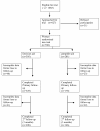Assisting informed decision making for labour analgesia: a randomised controlled trial of a decision aid for labour analgesia versus a pamphlet
- PMID: 20377844
- PMCID: PMC2868791
- DOI: 10.1186/1471-2393-10-15
Assisting informed decision making for labour analgesia: a randomised controlled trial of a decision aid for labour analgesia versus a pamphlet
Abstract
Background: Most women use some method of pain relief during labour. There is extensive research evidence available of pharmacological pain relief during labour; however this evidence is not readily available to pregnant women. Decision aids are tools that present evidence based information and allow preference elicitation.
Methods: We developed a labour analgesia decision aid. Using a RCT design women either received a decision aid or a pamphlet. Eligible women were primiparous, > or = 37 weeks, planning a vaginal birth of a single infant and had sufficient English to complete the trial materials. We used a combination of affective (anxiety, satisfaction and participation in decision-making) and behavioural outcomes (intention and analgesia use) to assess the impact of the decision aid, which were assessed before labour.
Results: 596 women were randomised (395 decision aid group, 201 pamphlet group). There were significant differences in knowledge scores between the decision aid group and the pamphlet group (mean difference 8.6, 95% CI 3.70, 13.40). There were no differences between decisional conflict scores (mean difference -0.99 (95% CI -3.07, 1.07), or anxiety (mean difference 0.3, 95% CI -2.15, 1.50). The decision aid group were significantly more likely to consider their care providers opinion (RR 1.28 95%CI 0.64, 0.95). There were no differences in analgesia use and poor follow through between antenatal analgesia intentions and use.
Conclusions: This decision aid improves women's labour analgesia knowledge without increasing anxiety. Significantly, the decision aid group were more informed of labour analgesia options, and considered the opinion of their care providers more often when making their analgesia decisions, thus improving informed decision making.
Trial registration: Trial registration no: ISRCTN52287533.
Figures
References
-
- Hodnett E. Pain and women's satisfaction with the experience of childbirth: A systematic review. American Journal of Obstetrics & Gynecology. 2002;186(5):S160–S172. - PubMed
-
- Dickersin K. In: Effective care in pregnancy and childbirth. Chalmers I, Enkin M, Keirse MJN, editor. Oxford: Oxford University Press; 1989. Pharmacological control of pain during labour; pp. 913–945.
-
- Paech MJ. The King Edward Memorial Hospital 1,000 mother survey of methods of pain relief in labour. Anaesthesia and Intensive Care. 1991;19(3):393–399. - PubMed
Publication types
MeSH terms
Associated data
LinkOut - more resources
Full Text Sources



